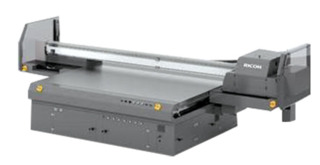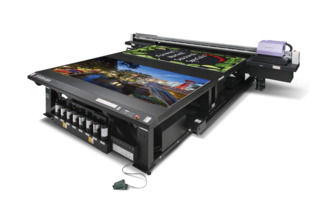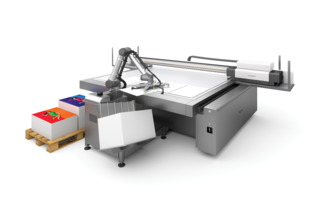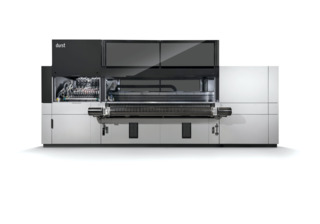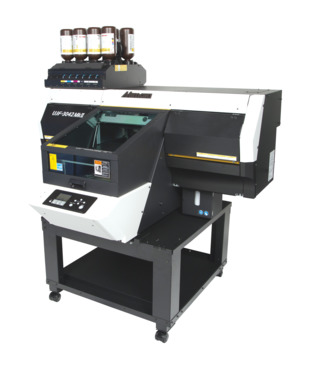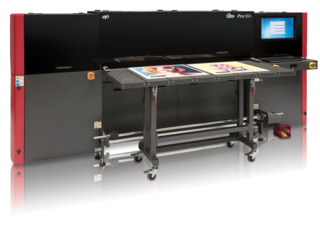Flatland: What’s New(s) and What’s Next for Flatbed Wide-Format Printers?
It’s been nearly 20 years since the advent of the flatbed wide-format printer. They’ve come a long way, baby; what’s new with the technology and where do they go from here?
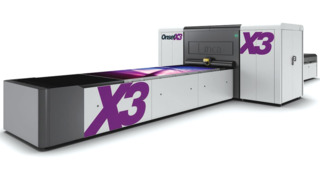
There has scarcely been a product category that has so completely changed the printing landscape as the flatbed wide-format printer, especially one that prints using UV-curable ink. (It’s rare to find non-UV flatbeds, although HP did launch a Latex flatbed last year.) It’s been nearly 20 years since the Inca Eagle swooped down into the market and launched the product category. Where do flatbeds stand today, and what is the future likely to hold? And how can shops profitably add flatbed printing to their roster of services?
Basic Needs
Over the years, flatbeds have evolved a slate of essential features, do-or-die functionality and capabilities. In addition to quality and speed as well as low cost of operation (“features” required by just about any printing equipment, really), the ability to print white ink has become crucial, while a roll-to-roll option is an important addition that expands a machine’s versatility. LED curing has largely supplanted traditional mercury vapor lamp curing. (EFI was one of the earliest adopters of LED UV curing for flatbed printing and virtually its entire fleet is LED. We will take a deep dive into the latest additions to the EFI flatbed—and textile—portfolio later this month when we cover EFI Connect.)
But as the range of applications that flatbeds can produce expands, an “essential” feature can be unique to each user. “Required features really depend on what type of applications a PSP predominantly produces today, but also what they see themselves producing in the future,” said Randy Paar, Marketing Manager, Display Graphics, Canon Solutions America (CSA).
As flatbeds proliferate, especially among new users, making them easy to get up and running is also becoming important. “Features that enable easy use are the most important features of a flatbed printer,” said Becky McConnell, Product Marketing Manager, Graphic Systems Division, Fujifilm North America Corporation. “A user interface that enables easy printing is key as print providers add digital printing capabilities to their business.”
“You’ve got to have good front-to-back accuracy, whether you’re printing on full-sized boards or precut sheets,” said Dan Johansen, Marketing Manager, Wide Format Solutions, Ricoh. “Many customers who get into the flatbed game, especially customers who are new to it, may not have a flatbed cutter onsite, so they’re buying precut boards from their local sign supply shop. Quite often they’re doing double-sided printing and you need good accuracy.”
As flatbeds have come to be suitable for printing on all kinds of different materials, and even 3D objects, the sticky issue (as it were) of ink adhesion must be addressed. While it’s often said that “flatbed UV printers can print on virtually anything,” the fact is that the same ink won’t print on every surface, or at least not without some kind of chemical assistance. “There are a lot of customers that are printing on everyday items like USB drives, smartphone cases, and all kinds of different things,” said Michael Maxwell, Senior Product Manager, Mimaki USA. “Some of the do-or-die flatbed features that have popped up as a result of that are the need for adhesion promotion. That’s become a very hot topic in the flatbed arena because you could print on virtually anything but you can’t necessarily get the ink to stick to everything.” Mimaki introduced a primer several years ago to facilitate ink adhesion on troublesome surfaces and is now on its fourth or fifth generation of products that support that.
And with the expanding range of applications, you probably need to consider the maximum thickness a machine supports. “Most major flatbeds print on surfaces up to a couple of inches thick,” said Johansen. “Some people like the ability to print on even thicker materials.” Ricoh’s new flatbeds can print up to 4.3 inches thick. Some other units can go even up to eight inches if needed.
What About Automation?
One topic that is common across all the disparate segments of the printing industry is automation. While it took a while for wide format to have the automation conversation, it has started in earnest—a result of the convergence of all these segments.
“We’ve offered full automation for our equipment, but up until now there just hadn’t been that much demand for it,” said Larry D’Amico, Director of Sales, North America, Durst U.S. But, he added, “I see that has changed in the last couple of years. People are starting to understand the labor costs associated with hand-feeding sheets and the benefits associated with complete automation. I see automation being a much more desirable option today than it was two or three years ago.”
To that end, you are seeing more and more autoloading and unloading options for flatbeds and even robotic arms.
New Dimensions
The improved accuracy and consistent ink placement of today’s flatbeds has also driven an interest in “layered” printing: repeatedly laying down layers of ink or varnish to build up textures or 3D effects. “We have seen a lot of interest in texture printing,” said Carmen Eicher, Product Manager, swissQprint. “Flatbed printers are perfectly suited for building up haptic effects because they are able to print layer by layer with the substrate staying perfectly in position.”
“The registration capabilities of a true flatbed allow for ink to repeatedly lay down in the same location,” said McConnell. “This has enabled the trend of textured printing to bring some new offerings to the market. Whether it be to mock a surface feeling or appearance, the building of ink opens the door to new, high-profit applications for print providers. As scanning technology continues to advance, I think we will continue to see opportunities with textured printing.”
“The Anapurna FB2540i and Jeti Mira flatbed printers can create dimensional printing. Ink is layered and elevated in certain areas of the graphic to achieve a tactile or thick oil painting effect that grabs viewers’ attention,” said Bill Brouhle, Senior Application Specialist, Agfa Graphics. “In combination with dimensional printing, the Jeti Mira can incorporate varnish which adds a spot of gloss to highlight a certain area of the graphic.” This layering of varnish in combination with Agfa’s 3D Lens Technology also allows for some cool lenticular effects, which I wrote about a few years ago.
Newest Industry
The capabilities of flatbeds have also allowed the devices to find no small number of applications in various kinds of “industrial printing.” “There are increasingly more manufacturing types of applications and related customers that use the flatbed printer to apply graphics to something they manufacture and sell,” said Paar. “In other words, their business is about selling a product rather than selling printing. This could be anything from instrument gauges to custom decorative elements to furniture with printed woodgrain to resemble something far more expensive.”
“We’re seeing a lot more wood decorating,” said Maxwell. “The home decor market is really pushing a lot of unique applications that haven’t traditionally been focused on flatbeds. Initially, flatbeds were very sign and graphics-oriented products, but now we’re seeing a lot of adoption for posters and backlits. We’re seeing a lot of adoption in canvas printing, and a lot of the decorative items that you would see if you walked through a home décor shop like Michael’s or Hobby Lobby.”
Some industrial applications may not be printable right out of the box, but manufacturers are finding requests for specialty industrial applications and developing unique solutions for individual clients.
“We’re seeing a lot of interest in the luxury vinyl floor market right now, and I could see that being a fairly significant segment,” said D’Amico. “There are about five major players in United States and they are definitely looking [at digital printing]. There are some challenges in that application that may require a different ink for the process, but that’s probably the one industrial market I think that has some pretty serious potential that we’re looking at a close way.”
“swissQprint has supplied a number of printers for industrial printing like membrane input devices, industrial signage, glass panels for interior decoration, furniture fronts, flooring, etc.,” said Eicher. “Industrial projects often involve adaptations of the machine to integrate it into the manufacturing process. Since swissQprint R&D and production are under one roof we are able to handle such special projects.”
“We definitely have a lot of customers in the industrial printing category that are producing anything from watch faces to dial gauges for air pressure applications, petrochemical, those types of things,” said Maxwell. “Membranes, switches—we’re seeing a lot of customers that are implementing these digital workflows. And the UJF is a big part of that because it has a small footprint so it can easily be incorporated into their manufacturing line with very little space requirement.”
We often think of “flatbeds” as large-scale units, but the category also includes table- or benchtop UV printers units that can print on specialty items. Mimaki’s UJF series fall into this category. Roland also offers benchtop UV units in its VersaUV series (which also includes a 64-inch flatbed and 48-inch hybrid).
Promoting Profitability
These days, selecting and installing a flatbed is easier, but running a flatbed profitably is a whole other matter. The same could be said for virtually any kind of printing, true, but the costs associated with flatbeds—inks, substrates, etc.—can be more substantial than for other kinds of wide-format printing, and certainly other kinds of commercial printing. One way of boosting profitability to get definitive numbers on costs. That seems obvious, but, said Paar, “surprisingly, we encounter many PSPs that don’t really know how much it is costing them to produce each of their jobs.” MIS and other software is beyond the scope of this story, but using software to determine what your costs actually are is an important part of flatbed profitability.
Optimizing quality is also a prime way of ensuring that jobs remain profitable, and to optimize quality you have to optimize the entire production process. “A part of the installation is customizing the inkjet workflow from prepress file optimization, color management from trusted G7 Masters, to maximizing finishing and utilization of every square inch of the preferred substrates,” said Brouhle. “During training, there are substrate specific tips and tricks the color management specialists impart with the operators to make sure they can achieve the best results possible from their new investment.”
“Simple things like waste can be the enemy of the PSP and I think many battle with this on an ongoing basis, especially if they are keen to keep an eye on costs of goods,” said Johansen. “Waste can be a significant factor and getting control of that can be critical, so workflow options that allow people to gang up work can be really important to minimize waste throughout, especially in an on-demand world.” Nesting optimization, for example, is becoming a key strategy to waste management.
Narrowing one’s focus is also a way of ensuring that your flatbed venture is a success. “Focusing on a particular application to begin with is kind of critical,” said Maxwell. “Don’t try to do a hundred different things all at once. Start small. Once you’ve got a focus on something, people are going to buy it, and it’s going to be really easy for you to turn a profit.”
Then there is the fun part: the creative aspect. “Continue to bring new ideas to existing and new clients,” said McConnell. “With a flatbed printer, the application potential is impressive which gives print providers the opportunity to ‘wow’ brands and clients. Don’t be afraid to push clients and prospects to take advantage of the impressive substrates and applications that can take them to the next level.”
OK. OK. What’s Next?
The holy trinity improvements—speed, price, quality—will no doubt continue. The biggest developments will likely be in ink development and other improvements and enhancements that make flatbeds suitable for even more applications.
“Certainly the graphics market is familiar with the capabilities of flatbed printing, but other vertical markets—such as manufacturers—have still not discovered flatbed UV printing for their unique applications,” said CSA’s Paar. “I would expect flatbed printer manufacturers will begin to increasingly adapt their product designs to accommodate this new breed of customers.”
“We believe we will see further integration into industrial printing applications with more production improvements especially as more advancements in ink and printhead technologies are released,” said Agfa’s Brouhle.
Which raises an interesting question: will UV always be the dominant ink technology for flatbed printing? So far, no other ink technology has proven to be as versatile. You have to think that an aqueous ink that has all the quality and versatility of UV but is more environmentally friendly and safer to use would be the Holy Grail of inkjet development. Sure, such an ink may be the chemical equivalent of a perpetual-motion machine, but you gotta believe that it’s an ink chemist’s dream. And Durst, for one, has been developing its aqueous Water Technology Inks for its packaging presses. But then much packaging has unique requirements ink-wise.
“There’s an aqueous vs. UV debate and we offer both, so we sort of feel like we can be a little more unbiased,” said Durst’s D’Amico. “But we are finding some real interest on the aqueous capability that we offer around packaging. At the end of the day, can you pass the Swiss ordinance, can you pass the Nestle test , can you pass the Hershey test, and we pretty much have most of those qualifications today with the aqueous ink. That’s probably the important aspect to it if you’re doing any kind of food applications.”
But one interesting development is that as flatbeds are used for new applications, they’re being installed in different kinds of environments which can affect how they perform. “When you go into an industrial space, there’s a lot of airflow, sometimes there are a lot of things moving around, and they’re creating drop placement inaccuracies,” said Mimaki’s Maxwell. “You’d see printers being incorporated into spaces with waterjets or plasma cutters and those devices create particulates in the air which can contaminate the ink and produce adhesion issues.” So tweaking the design of the press—closing the casing up, for example—is a way of ensuring that a printer can actually function optimally in the space in which it is installed.
And of course automation automation automation. “Automation will be a frontier that continues to be pushed as people are using wide format,” said Ricoh’s Johansen. “Automation is going to be the key to seeing future growth in the platform.”

